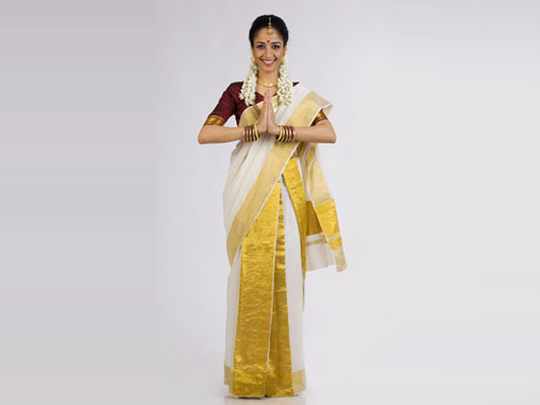
Though we grew up in Mumbai and embraced the city’s cosmopolitan outlook in every way, Onam was one of those times of the year when my mother and all my visiting aunts pulled out their preciously stored, shimmering gold kasavu (cream with golden-bordered) saris or two-piece onnara mundu ensembles. This instantly transformed them into mini ambassadors of Kerala.
Historically appearing in ancient Buddhist and Jain literature, kasavu saris and the onnara mundu are modern adaptations from clothing worn during the pre-Hindu, Buddhist and Jain cultures that once flourished in Kerala and several other parts of South India.
The kasavu sari or the Kerala sari has its own elegant charm. While the basic sari is a simple creamy white, its beauty comes from the juxtaposition of the shimmering golden borders coupled with motifs such as peacocks, mango leaves, parrots, deer or scenes from ancient stories. The thicker the gold, the more expensive the sari and the more admired the woman wearing it. While older women prefer the stark cream and gold, younger generations opt for gold borders that alternate with vibrant colours and motifs. Not that the men are left out: on such an occasion, a Keralite would wear a white shirt and a mundu with a thin gold border. The mundu is a long garment worn around the waist and is similar to a sarong or a lungi.
Social status
“About 400 years ago, due to foreign influences and cultures, clothes became a matter of social status among members of the royal family. The rulers of Travancore started to establish ‘weaver streets’ by taking weavers from the Cholas (Tamil Nadu). They were given the exclusive duty of producing the mundu and the kavani (melmundu or garment for the upper part of the body) for the Travancore royal family and their relatives,” says K. Chandran, Technical Superintendent (processing) at the Indian Institute of Handloom Technology (IIHT), a training institute based in Kannur, Kerala.
Imported influence
During the period of king Balarama Varma (1798-1827 AD) and under the leadership of the prime minister, Diwan Ummini Thampi, weavers were brought from Valliyoor in the neighbouring state of Tamil Nadu to work in weaving streets such as Ottatheru, Irattatheru, Puthentheru and Vinayakar Theru at Balaramapuram. This area also featured markets known as Chanthai. Thus, the town of Balaramapuram started with 300 weaving families and four streets. It went on to become the centre of kasavu and mundu production in Kerala. Over the last century, it has become a handloom cluster with about 10,000 weavers.
Chandran says the special chutti (border) and kattikara (the cross border where the lengthwise border of the sari crosses the pallu border) were known as puliyilakara mundu since the initial chutti design resembled the leaves of the puli or tamarind tree.
“It was only in the last century that the kasavu (golden sari thread) was added to the border designs, making it known as the Kerala sari,” he says, citing references from authors such as O. Krishnan Patyam, K. Sivasankaran Nair and P.K. Padmanabhan Nair.
“In the last two decades, the Kerala government has invested in this sector through organisations such as Hantex, a Co-operative Society of Handloom weavers, the Kerala State Handloom Development Corporation and IIHT. The government not only assists with the prices of raw materials but also implements projects to ensure that the designs meet the demands from contemporary consumers while holding on to its traditional feel,” adds Chandran.
“Though these saris look simple to the untrained eye, prices can begin from Rs2,000 (about Dh160) and can go up to Rs1,00,000,” says Vanaja Susheelan, owner of Kasavukada, one of the traditional kasavu companies headquartered in Thiruvananthapuram.
The price connection
“Whenever gold prices increase, we have to raise the prices of the saris,” she says. Gold touched a record $1,895 (about Dh6,959) per ounce in August and experts predict the price will continue rising.
“However, we still see a 25 per cent increase in business year after year. The demand for these saris will always remain, regardless of changes in fashion industry. While the peacock motif is still the popular one, we also study fashion trends and make slight changes every year to the traditional designs that cater to the younger buyers,” she adds.
Those wishing to turn out in their traditional finery must head to Dubai’s Mina Bazaar area in Bur Dubai.
However, not all kasavu is the real thing (see box). Alternatively, you can order them online from Kasavukada, Karalkada or other manufacturers in Kerala. Even better, for a cost-effective, hassle-free solution, simply ask a Malayali friend or acquaintance to bring one back for you from their trips back home.
How to spot a fake from a real kasavu sari
Genuine kasavu yarn is a product of a metallic threading process that fuses copper, silver and gold (gold content 0.1 per cent) with a silk filament using electrolysis technology. These threads are called fine zari or kasavu. Today, most kasavu saris and mundus are designed with imitation zari threads, or half-fine zari. This is produced by a similar process, but does not use silver or gold.
What to look for when buying kasavu
- The silk thread core at the centre of the real zari must be red in colour, whereas other varieties will reveal a white core. Rub the thread for a little between your fingers or against a hard surface for a little while to expose the red core.
- Take a coin and rub the kasavu part of the sari or mundu three
- or four times. If you find that the rubbed portion is a silver gray colour, this means that the zari is real. Fakes will reveal black, greenish, blue or other colours.
- Spread the fabric over a table and examine the kasavu edges. Real zari will exhibit its metallic tendencies, which is to roll or fold inwards into the fabric. Fakes will show loosened or creased edges. On ironing, the borders may even expand from their original position.
- Final confirmation tests can be carried out with accuracy at specialist chemical laboratories.
(Courtesy: Indian Institute of Handloom Technology)












